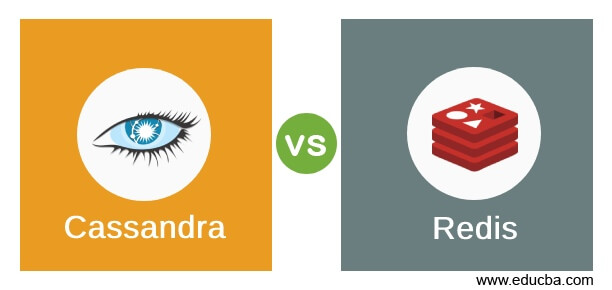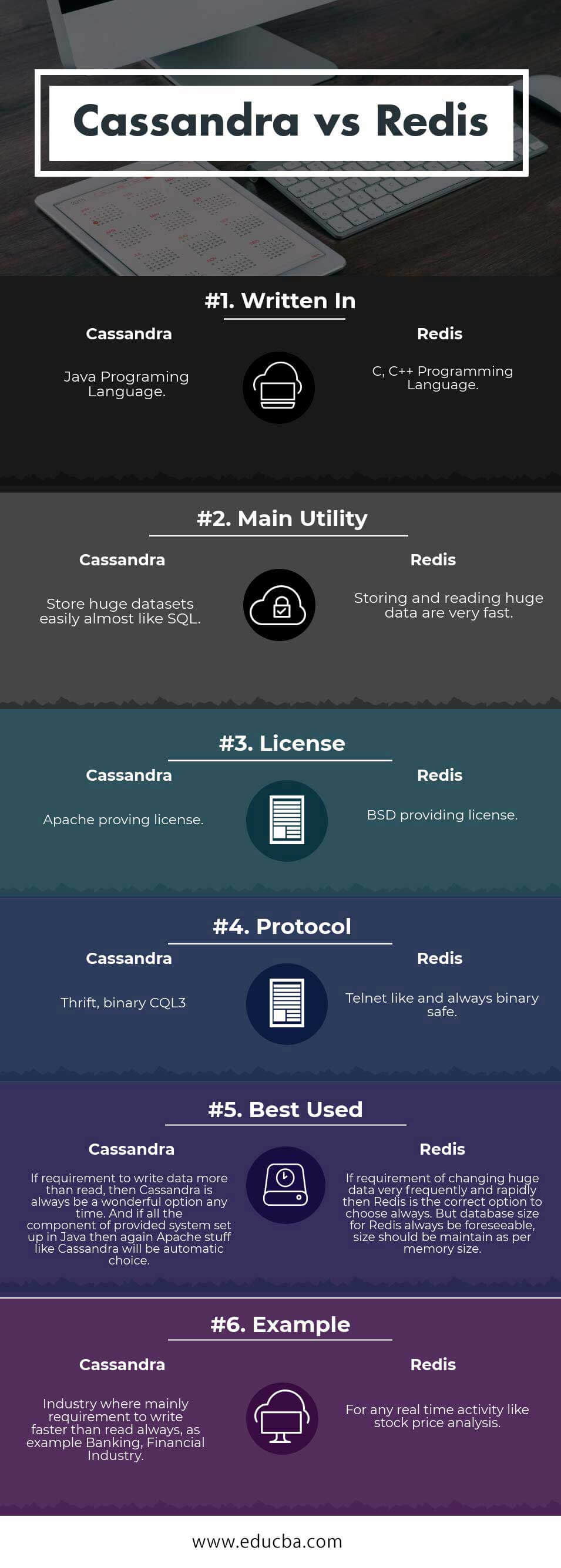Updated May 4, 2023
Difference Between Cassandra vs Redis
Cassandra and Redis usually are used for fetching and storing vast amounts of data quickly and helping complete live streaming with massive amounts of data efficiently. As Cassandra is an Apache product, one of the great benefits of using Cassandra is that it supports HiveQL (SQL-like syntax). Cassandra follows the structure of a regular column/table format-oriented database which the historical RDMS very well supports. It also does not support total CAP (Consistency, Availability, and Partition Tolerance), which can be considered the same as AP (availability and partition tolerance). Suppose you have a business requirement to write or store more data in the system rather than read data, then Cassandra will be one of the good options. That’s why Cassandra is too popular with some specific industries like banking or financial, where the typical attitude to writing is more than reading (considering entire data, including transaction data).
Redis is faster than Cassandra in the form of big data fetching and storing, especially in the case of live streaming. Redis typically maintains a disk-backed in-memory database. It usually supports master-slave architecture (as the following line with Hadoop Architecture). And the exciting point, it mainly followed CP (means consistency and Partition Tolerance) in CAP (Consistency, Availability, and Partition Tolerance) theorem. If an organization has rapidly changing massive data, using Redis without considering any other option will be great. But as Radis mainly in a memory database, it should have some approximate data size estimation, which considers memory size and all. For any analytics with accurate data and integrating real-time data streaming with massive data, Redis always be an excellent option for any industry.
Now it is one of the big concerns for any software architect to choose an exact tool for processing massive live data based on industry requirements. Sometimes one specific organization has two different kinds of conditions that may need to follow by both Cassandra vs Redis.
Head-to-Head Comparison Between Cassandra vs Redis (Infographics)
Below are the top 6 comparisons between Cassandra vs Redis:
Key Differences Between Cassandra vs Redis
Below are the lists of points that describe the key differences between Cassandra vs Redis:
- Cassandra has been preferable writing more and reading fewer situations. Redis is always used for rapidly changed data on both write and read.
- Cassandra can hold vast amounts of data in a tabular format that supports HiveQL (SQL-like language). In contrast, Redis stores the data as a key-value pair which generally does not keep any SQL-like language.
- Cassandra has written in Java, whereas Redis is written in C and C++.
- Cassandra typically follows a disk-bound in-memory database, whereas Redis follows disk backed in-memory database.
- Compared to CAP (Consistency, Availability, and Partition Tolerance) theorem, Cassandra follows AP (Availability and Partition Tolerance), whereas Redis follows CP (Consistency and Partition Tolerance).
- Disk swap can be possible for Cassandra, so have importance on VM or Disk store, whereas VM and Disk Store are abandoned for Redis as disk swap is currently unavailable for Redis.
- Cassandra is a tuneable trade-off policy in the case of distribution and replication (N, R, W). At the same time, Redis follows proper Master-Slave replication in-memory database.
- Cassandra supports everyday query-type language, so query by column or range of verities keys or data searching criteria can be easily reachable. Redis returns simple values or hash tables by key, storing data as key-value pairs.
- Cassandra follows big table-like features and holds column or column families for the list of data. Whereas Redis has no column concept, it permanently stores data as key-value pairs.
- Redis will always be better for executing range queries as it has sorted set options with a high score table structure. In contrast, Cassandra needs to write a proper query to fetch those costly data, which is not much fast as Redis.
- Redis has special utilities like sets, lists, and hashes, which help for doing union, difference, inter-sector, returning queue or blocking POP, and returning an object of multiple fields. Whereas for Cassandra, we always need to write queries to do the same.
Cassandra vs Redis Comparison Table
Below is the comparison table between Cassandra and Redis.
| Basis For Comparison | Cassandra | Redis |
| Written In | Java Programing Language. | C, C++ Programming Language. |
| Main Utility | Store huge datasets easily, almost like SQL. | Storing and reading huge amounts of data are very fast. |
| License | Apache proving license. | BSD is providing the license. |
| Protocol | Thrift, binary CQL3. | Telnet-like and always binary safe. |
| Best Used | If the requirement is to write data more than reading, then Cassandra is always an excellent option at any time. And if all the components of the provided system are set up in Java, then again, Apache stuff like Cassandra will be an automatic choice. | If there is a requirement to change vast amounts of data very frequently and rapidly, then Redis is the correct option always to choose. But database size for Redis always is foreseeable. Size should be maintained as per memory size. |
| Example | An industry where mainly required to write faster than always read, for example, Banking, Financial Industry. | For any real-time activity like stock price analysis. |
Conclusion
Considering the above discussion, our conclusion of choosing Cassandra or Redis will depend on the kind of below parameters:
- Do you need a Key-Value relationship for your current implementation? – Then Redis is always best.
- Is there a rapidly changed in data? – Again, Redis is the best choice.
- If Write would be more than reading? – Cassandra will be the best choice.
- If Read is more than writing or working with very frequent data? – Then Redis will be a good choice.
- Considering the Fault tolerance option – Then Cassandra will be a little better than Redis as it follows proper Hadoop architecture.
- In the case of persistence session data – Redis will be better.
A conclusion is if an organization needs to store vast amounts of data and use the same for analyzing reports in some schedule time gap, then Cassandra will be a perfect option for any condition. But if the organization wants to generate analytics on current live streaming data every time, then obviously, Redis is always the best option. Because Redis is faster than Cassandra anyway in case of reading and writing huge amounts of data especially live streaming data.
Recommended Articles
This has been a guide to Cassandra vs Redis. Here we have discussed Cassandra vs Redis head-to-head comparison, key differences, infographics, and comparison table. You may also look at the following articles to learn more –




